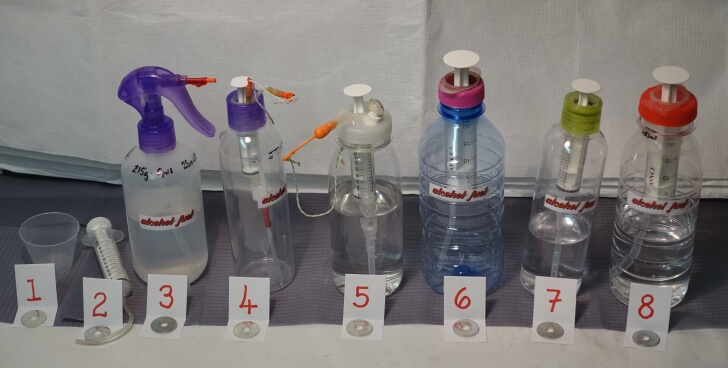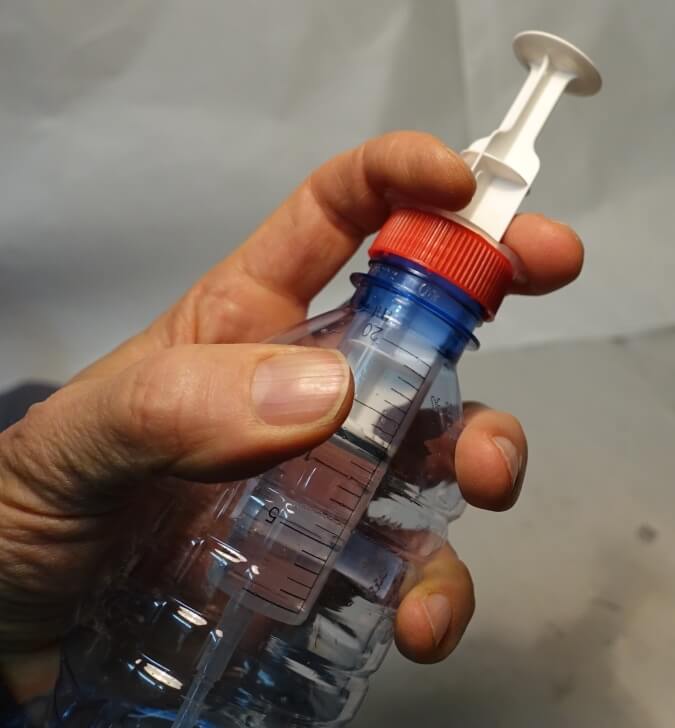The Lambda stove is my personal MYOG Alcohol Stove that I plan on writing a future article about. This article will cover the Snuffle Flask an alcohol fuel dispenser than can be used with any alcohol stove. A fuel efficient cooking system consists of a stove, the environment, one's fuel supply, the ability to measure, a lighter/starter, a pot, a pot stand, and a windshield. Each item has to work together properly to create an efficient system.
The Snuffle Flask is a fuel bottle with an integrated fuel measuring and dispensing system. It is a simple and reliable way to fill the exact amount of alcohol needed for any alcohol stove without utilizing multiple devices.
Disclaimer
This project is not a beginner's project. You will be working with very sharp tools. Be sure you have the necessary experience to work safely with the tools you will be using. And: alcohol fuel burns. Use common sense and don't burn yourself or anything else.
Measuring fuel without the Snuffle Flask
Everyone who has operated alcohol stoves knows that accurately measuring the amount of alcohol going in the stove is challenging. You are supposed to use a small measuring cup, but if you are tired and hungry, filling the necessary amount of alcohol into the cup is difficult. Trying to get a decent read on the amount of alcohol poured when it's dark is difficult also. It is difficult to fill the stove without spilling, to keep track of the fuel bottle cap, and to keep the fuel bottle from tipping over. After all, you are in the backcountry, far from any picnic table. Also, dexterity and intellectual abilities tend to deteriorate rapidly once a person gets tired and hungry.
The video clips on youtube make operating an alcohol stove look easy. Alcohol stoves can be quite sensitive to their environment. The usual "penny stove” will die in anything but warm and sunny conditions. I have once used nearly 10.1 oz. (300ml) of alcohol to cook 33.8 oz. (1 liter) of soup. I missed a warm meal once because of this. Here is my solution to provide a no fuss, no fumble, no spilling, and easy to operate system that works under most conditions encountered on backpacking trips. The system described can even be operated wearing gloves.
The core element of the system is the fuel bottle. For one to two person use, a fuel bottle of 8.5 oz. (250ml) to 11.8 oz. (350ml) is fine (for me) and will work for a couple of meals. Actually, one single 11.8 oz. (350ml) bottle of fuel (yellow "Heet") was more than plenty for a 5-day/4-night summer trip my wife and I took in the Sierra Nevada. We were at 10'000 ft+ (3048 m+) elevation and had dried meals to rehydrate and no restrictions on the amount of tea, coffee, soup, etc. For 2 to 3 people or for longer trips, I may take a 16.9 oz. (500ml) bottle, or I may prefer to refill my smaller bottle every once in a while. Larger groups will carry more than one system, especially when will have to melt snow to get their water.
The diameter of the bottle cap matters when wearing gloves. There are mainly three sizes of bottle cap diameters on the most popular PET bottles. Water or pop/soda bottles usually come with cap diameters of 1.1 in. (29mm) or 1.3 in. (32mm). You will also find the lightest bottles in this group. You might feel they are a bit on the flimsy side for a fuel bottle. I believe, however, that they are okay as I integrate them into my system and carry them in my backpack, protected by the windshield and another (flimsy) PET-container. Lightweight gear is designed for use, not for abuse. If you want to abuse your gear, go to the army surplus store. The bottles containing fruit juices and smoothies come with 1.6 in. (40mm) caps and tend to be a bit sturdier. The 1.6 in. (40mm) caps are nice to operate with your gloves on, too.
Developing the Fueling System: The Stages of Error

- The usual measuring cup. There is no easy read of the amount measured.
- This was my system during the 2015 season. It consisted of a 10ml syringe fitted with a short length of flexible fuel tubing from the RC model hobby shop. It is easy to read, but the fuel cap has to be taken off and left unattended during operation. The flexible tubing can direct the alcohol into the wrong compartment of the stove if you are using a Trail Designs 10-12 stove, for example. A piece of stiff tubing is a wiser choice.
- This model is an air freshener pump with a drilled out nozzle fitted to your fuel bottle. Needs two hundred (sic!) pump strokes to get out .7 oz. (20ml) of alcohol. Not trail worthy!
- This was my first attempt with a built-in .2 oz. (5ml) syringe and also with two valves from a foot freshener spray. A real pump puts out .2 oz. (5ml) of alcohol on each stroke. Aptly called the "Snuffle Flask" by my elder son, the flask needs an air bleed device to let in some air, so there are three holes in your bottle cap. The holes pose sealing issues. The two caps used as an air bleeding device and fuel spout are prone to leakage, too.
- The photo shows the enhanced Snuffle Flask with an air bleed screw and larger diameter bottle cap to accept a 10ml syringe. Handling all three devices on the cap at the same time is still a bit fiddly (open air bleed screw, uncap fuel outlet, pump the necessary amount, close all openings again). At least, there are no items of which to keep track. Everything is attached to the fuel bottle. There are still three holes in the bottle cap that are prone to leakage. The air bleed is a screw that is a bit tricky to manufacture. During a family discussion, I proposed to skip the air bleed screw and replace its function by merely untightening the bottle cap. Whereupon, my elder son proposed to leave out everything except the syringe mounted to the cap – bingo!
- This photo depicts the first versions of the final design of Snuffle Flask. Leakage remained a problem, as gluing a syringe to a bottle cap is problematic, i.e. the soapy type of plastic used for bottle caps tends to split from any type glue.
- This is the first coupling-nut system. This system presses everything down on a sealing ring. It is fuel tight and trail-worthy.
- Same as #6.
Fuel Bottle Design and Construction of the Snuffle Flask
I will show you three fuel bottles
- The "Simple-simple Flask" may leak unless you are proficient with hot glue or find a lucky combination of a syringe and bottle cap (see pics 02, 45 and 46);
- The "Screw-on cap Flask" is the "normal" choice for anyone. It uses a wide cap (see pic 51, the right flask); and
- The "Coupling-nut Flask," is probably the safest example, but a bit tricky to make (see pics 51, left flask, and pic 65). Choose a bottle with a large cap if you intend to operate it wearing gloves.
Read on to here how to make the Snuffle Flask
Article Outline
- Introduction
- Fuel Bottle Design and Construction of the Snuffle Flask
- Operation
- Conclusion
# of Photos: 60; Word Count: 5900
Member Exclusive
A Premium or Unlimited Membership* is required to view the rest of this article.
* A Basic Membership is required to view Member Q&A events




Home › Forums › How to Make a Lightweight Fuel Dispenser for Alcohol Stoves (the Snuffle Flask)